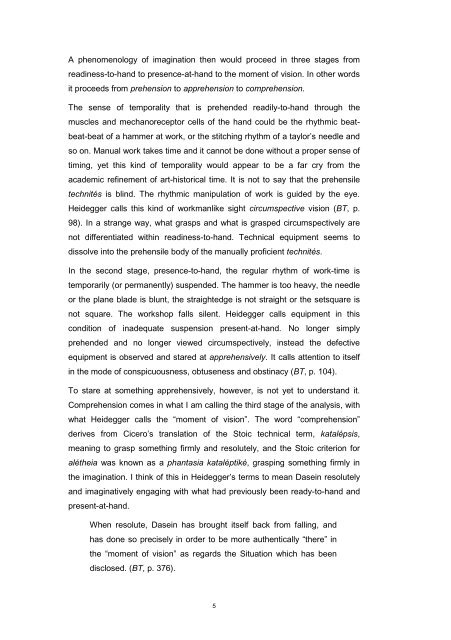Within-time-ness and history.pdf - ResearchSpace@Auckland
Within-time-ness and history.pdf - ResearchSpace@Auckland
Within-time-ness and history.pdf - ResearchSpace@Auckland
You also want an ePaper? Increase the reach of your titles
YUMPU automatically turns print PDFs into web optimized ePapers that Google loves.
A phenomenology of imagination then would proceed in three stages from<br />
readi<strong>ness</strong>-to-h<strong>and</strong> to presence-at-h<strong>and</strong> to the moment of vision. In other words<br />
it proceeds from prehension to apprehension to comprehension.<br />
The sense of temporality that is prehended readily-to-h<strong>and</strong> through the<br />
muscles <strong>and</strong> mechanoreceptor cells of the h<strong>and</strong> could be the rhythmic beatbeat-beat<br />
of a hammer at work, or the stitching rhythm of a taylor’s needle <strong>and</strong><br />
so on. Manual work takes <strong>time</strong> <strong>and</strong> it cannot be done without a proper sense of<br />
timing, yet this kind of temporality would appear to be a far cry from the<br />
academic refinement of art-historical <strong>time</strong>. It is not to say that the prehensile<br />
technités is blind. The rhythmic manipulation of work is guided by the eye.<br />
Heidegger calls this kind of workmanlike sight circumspective vision (BT, p.<br />
98). In a strange way, what grasps <strong>and</strong> what is grasped circumspectively are<br />
not differentiated within readi<strong>ness</strong>-to-h<strong>and</strong>. Technical equipment seems to<br />
dissolve into the prehensile body of the manually proficient technités.<br />
In the second stage, presence-to-h<strong>and</strong>, the regular rhythm of work-<strong>time</strong> is<br />
temporarily (or permanently) suspended. The hammer is too heavy, the needle<br />
or the plane blade is blunt, the straightedge is not straight or the setsquare is<br />
not square. The workshop falls silent. Heidegger calls equipment in this<br />
condition of inadequate suspension present-at-h<strong>and</strong>. No longer simply<br />
prehended <strong>and</strong> no longer viewed circumspectively, instead the defective<br />
equipment is observed <strong>and</strong> stared at apprehensively. It calls attention to itself<br />
in the mode of conspicuous<strong>ness</strong>, obtuse<strong>ness</strong> <strong>and</strong> obstinacy (BT, p. 104).<br />
To stare at something apprehensively, however, is not yet to underst<strong>and</strong> it.<br />
Comprehension comes in what I am calling the third stage of the analysis, with<br />
what Heidegger calls the “moment of vision”. The word “comprehension”<br />
derives from Cicero’s translation of the Stoic technical term, katalépsis,<br />
meaning to grasp something firmly <strong>and</strong> resolutely, <strong>and</strong> the Stoic criterion for<br />
alétheia was known as a phantasia kataléptiké, grasping something firmly in<br />
the imagination. I think of this in Heidegger’s terms to mean Dasein resolutely<br />
<strong>and</strong> imaginatively engaging with what had previously been ready-to-h<strong>and</strong> <strong>and</strong><br />
present-at-h<strong>and</strong>.<br />
When resolute, Dasein has brought itself back from falling, <strong>and</strong><br />
has done so precisely in order to be more authentically “there” in<br />
the “moment of vision” as regards the Situation which has been<br />
disclosed. (BT, p. 376).<br />
5















